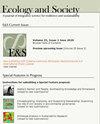对夏威夷夏威夷小船渔业调查的自动内容分析揭示了微妙的、不断演变的冲突
IF 3.2
2区 社会学
Q1 ECOLOGY
引用次数: 0
摘要
手动内容分析提供了一种系统可靠的方法来分析叙述性文本中的模式,但对于较大的数据集,人工编码是不可行的,自动内容分析方法提供了诱人的和省时的解决方案来自动分类文本模式。然而,需要大量的数据集和分析这些大数据集的复杂性阻碍了它们在渔业科学中的应用。渔业科学家通常处理中等规模的数据集,这些数据集不够大,不足以保证复杂的自动化技术的复杂性,但也不够小,无法进行成本有效的手工分析。对于这些情况,基于字典的自动化内容分析技术可以在不失去上下文敏感性的情况下简化自动化过程。在这里,我们建立并测试了一个特定于渔业的数据字典,用于对夏威夷夏威夷小船渔业调查中的开放式回答进行自动内容分析,以检查渔业冲突的性质。在本文中,我们描述了该方法的总体性能,创建和应用字典到渔业数据,以及该方法的优点和局限性。结果表明,字典方法能够快速准确地将非结构化渔业数据分类为结构化数据,并且有助于揭示渔业管理中经常模糊和被忽视的根深蒂固的冲突。除了为该方法提供概念证明之外,字典还可以在后续的调查中重用,以继续监视这些冲突的演变。此外,这种方法可以更广泛地应用于渔业和自然资源养护科学领域,为方法工具箱提供了宝贵的补充。本文章由计算机程序翻译,如有差异,请以英文原文为准。
Automated content analysis of the Hawaiʻi small boat fishery survey reveals nuanced, evolving conflicts
Manual content analysis provides a systematic and reliable method to analyze patterns within a narrative text, but for larger datasets, where human coding is not feasible, automated content analysis methods present enticing and time-efficient solutions to classifying patterns of text automatically. However, the massive dataset needed and complexity of analyzing these large datasets have hindered their use in fishery science. Fishery scientists typically deal with intermediately sized datasets that are not large enough to warrant the complexity of sophisticated automated techniques, but that are also not small enough to cost-effectively analyze by hand. For these cases, a dictionary-based automated content analysis technique can potentially simplify the automation process without losing contextual sensitivity. Here, we built and tested a fisheries-specific data dictionary to conduct an automated content analysis of open-ended responses in a survey of the Hawaiʻi small boat fishery to examine the nature of the fishery conflict. In this paper we describe the overall performance of the methodology, creating and applying the dictionary to fishery data, as well as advantages and limitations of the method. The results indicate that the dictionary approach is capable of quickly and accurately classifying unstructured fisheries data into structured data, and that it was useful in revealing deeply rooted conflicts that are often ambiguous and overlooked in fisheries management. In addition to providing a proof of concept for the approach, the dictionary can be reused on subsequent waves of the survey to continue monitoring the evolution of these conflicts. Further, this approach can be applied within the field of fishery and natural resource conservation science more broadly, offering a valuable addition to the methodological toolbox.
求助全文
通过发布文献求助,成功后即可免费获取论文全文。
去求助
来源期刊

Ecology and Society
环境科学-生态学
CiteScore
6.20
自引率
4.90%
发文量
109
审稿时长
3 months
期刊介绍:
Ecology and Society is an electronic, peer-reviewed, multi-disciplinary journal devoted to the rapid dissemination of current research. Manuscript submission, peer review, and publication are all handled on the Internet. Software developed for the journal automates all clerical steps during peer review, facilitates a double-blind peer review process, and allows authors and editors to follow the progress of peer review on the Internet. As articles are accepted, they are published in an "Issue in Progress." At four month intervals the Issue-in-Progress is declared a New Issue, and subscribers receive the Table of Contents of the issue via email. Our turn-around time (submission to publication) averages around 350 days.
We encourage publication of special features. Special features are comprised of a set of manuscripts that address a single theme, and include an introductory and summary manuscript. The individual contributions are published in regular issues, and the special feature manuscripts are linked through a table of contents and announced on the journal''s main page.
The journal seeks papers that are novel, integrative and written in a way that is accessible to a wide audience that includes an array of disciplines from the natural sciences, social sciences, and the humanities concerned with the relationship between society and the life-supporting ecosystems on which human wellbeing ultimately depends.
 求助内容:
求助内容: 应助结果提醒方式:
应助结果提醒方式:


